Drake G.W.F. (editor) Handbook of Atomic, Molecular, and Optical Physics
Подождите немного. Документ загружается.

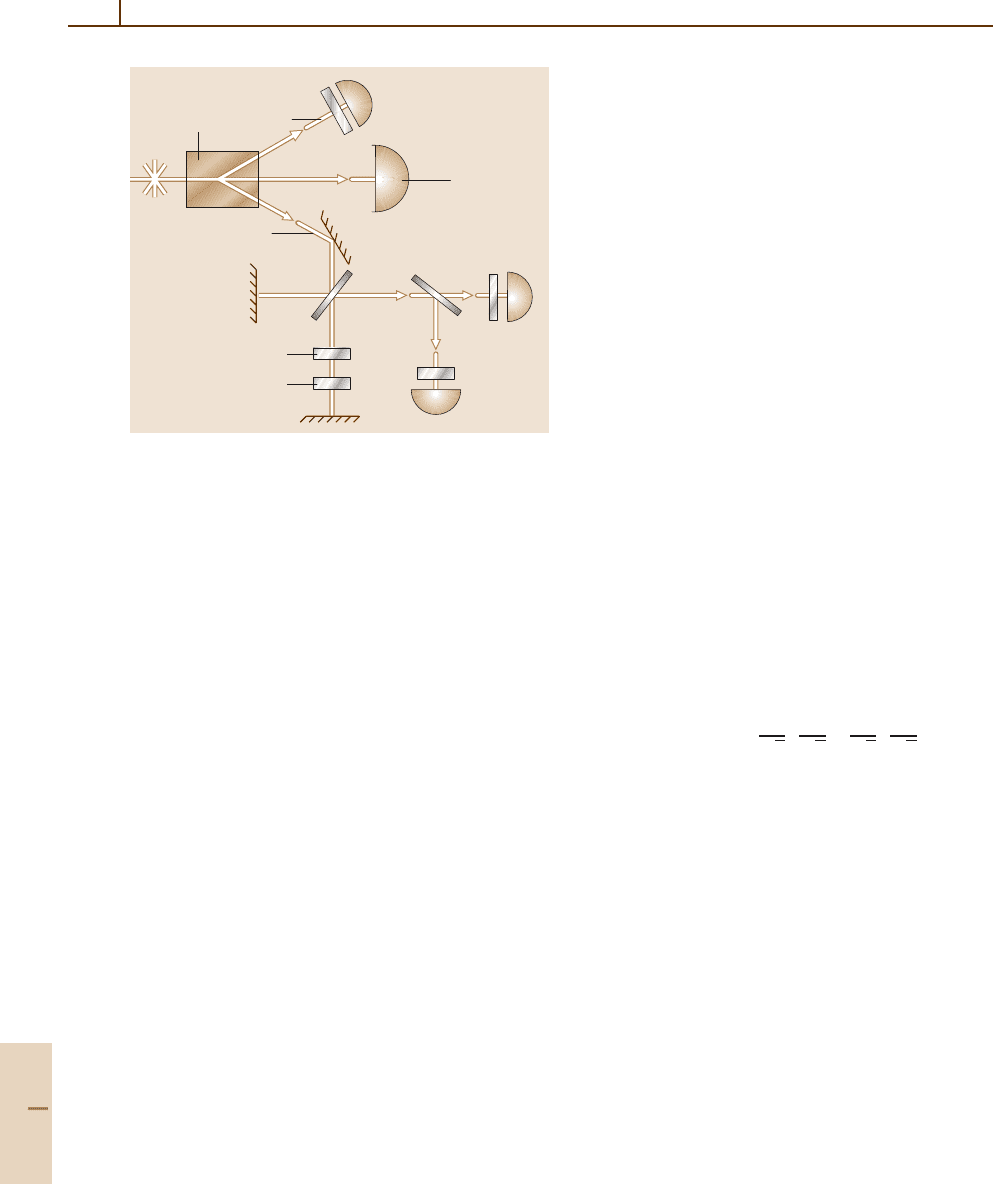
1190 Part F Quantum Optics
UV
laser
KDP
Idler
F1
D1
Signal
Beam dump
F2
D2
F3
D3
Fixed QWP
Rotatable QWP
Fig. 80.3 The energy–time uncertainty relation and wave
function collapse were studied by investigating the effect
of various filters before the detectors in a single-photon
interference experiment [80.5, 81]
there was no trigger, no fringes were observed, imply-
ing a much shorter wave packet. This is a nonlocal effect
in that the photons could in principle be arbitrarily far
away from each other when the collapse occurs.
80.3.3 Two-Photon Interference
In the above experiments, interference occurs between
two paths taken by a single photon. An early experi-
ment to demonstrate two-photon interference using the
down-conversion light source was performed by Ghosh
and Mandel [80.85]. They looked at the counting rate
of a detector illuminated by both of the twin beams.
No interference was observed at the detector, because
although the sum of the phases of the two beams emit-
ted in parametric fluorescence is well defined (by the
phase of the pump), their difference is not, due to the
number-phase uncertainty principle. However, the rate
of coincidence detections between two such detectors
whose separation was varied did display high-visibility
interference fringes. Whereas in the standard two-slit
experiment, interference occurs between the two paths
a single photon could have taken to reach a given point
on a screen, in this case it occurs between the possibility
that the signal photon reached detector 1 and the idler
photon detector 2, and the possibility that the reverse
happened. This experiment provides a manifestation of
quantum nonlocality; interference occurs between al-
ternate global histories of a system, not between local
fields. At a null of the coincidence fringes, the detection
of one photon at detector 1 excludes the possibility of
finding the conjugate photon at detector 2.
Such interference becomes clearer in the related
interferometer of Hong et al. [80.86](Fig.80.4). The
identically polarized conjugate photons from a down-
conversion crystal are directed to opposite sides of
a 50–50 beam splitter, such that the transmitted and
reflected modes overlap. If the difference in the path
lengths ∆L prior to the beam splitter is larger than
the two-photon correlation length (of the order of the
coherence length of the down-converted light), the pho-
tons behave independently at the beam splitter, and
coincidence counts between detectors in the two out-
put ports are observed half of the time – the other
half of the time both photons travel to the same de-
tector. However, when ∆L ≈ 0, such that the photon
wave packets overlap at the beam splitter, the probabil-
ity of coincidences is reduced, in principle to zero if
∆L = 0. One can explain the coincidence null at zero
path-length difference using the Feynman rules for cal-
culating probabilities: add the probability amplitudes of
indistinguishable processes which lead to the same fi-
nal outcome, and then take the absolute square. The two
indistinguishable processes here are both photons being
reflected at the beam splitter (with Feynman amplitude
r ·r) and both photons being transmitted (with Feyn-
man amplitude t ·t). The probability of a coincidence
detection is then
P
c
=|r ·r +t ·t|
2
=
i
√
2
·
i
√
2
+
1
√
2
·
1
√
2
2
= 0 ,
(80.6)
assuming a real transmission amplitude, and where the
factors of i come from the phase shift upon reflection at
a beam splitter [80.87, 88].
The possibility of a perfect null at the center
of the dip is indicative of a nonclassical effect. In-
deed, classical field predictions allow a maximum
coincidence-fringe visibility of only 50% [80.89].
The tendency of the photons to travel off together
at the beam splitter can be thought of as a man-
ifestation of the Bose–Einstein statistics for the
photons [80.90]. In practice, the bandwidth of the pho-
tons, and hence the width of the null, is determined
by filters and/or irises before the detectors [80.82].
Widths as small as 5 µm have been observed, cor-
responding to time delays of only 15 fs [80.91].
Consequently, one application is the determination of
single-photon propagation times with extremely high
time resolution (Sect. 80.8).
Part F 80.3

Quantum Optical Tests of the Foundations of Physics 80.4 Complementarity and Coherence 1191
80.4 Complementarity and Coherence
80.4.1 Wave–Particle Duality
The complementary nature of wave-like and particle-
like behavior is frequently interpreted as follows: due
to the uncertainty principle, any attempt to measure the
position (particle aspect) of a quantum leads to an un-
controllable, irreversible disturbance in its momentum,
thereby washing out any interference pattern (wave as-
pect) [80.93, 94]. This picture is incomplete though; no
“state reduction,” or “collapse,” is necessary to destroy
interference, and measurements which do not involve
reduction can be reversible. One must view the loss
of coherence as arising from an entanglement of the
system wave function with that of the measuring ap-
paratus (MA) [80.95]. Previously interfering paths can
thereby become distinguishable, such that no interfer-
ence is observed. Consider the simplest experiment,
a Mach–Zehnder interferometer with a 90
◦
polariza-
tion rotator in arm 1. If horizontally polarized light is
input, the state before the recombining beam splitter is
|1|V +|2|H)/
√
2
,where|1 and |2 indicate the
path of the photon. Because the polarization – playing
the role of the MA – labels the path, no interference is
observed at the output. Englert [80.96] has introduced
a generalized relation quantifying the interplay between
the wave-like attributes of a system (as measured by the
fringe visibility V) and the particle-like character (as
measured by the distinguishability D of the underlying
quantum processes):
V
2
+ D
2
≤ 1 . (80.7)
The equality holds for pure input states. This rela-
tion has now been well verified in optical systems
like that described above [80.97, 98], as well as in
atom interferometry (Sect. 77.6) [80.99]. In the latter,
the role of the polarization was played by internal en-
ergy states of an atom diffracted off a standing light
wave.
80.4.2 Quantum Eraser
The interference lost to entanglement may be re-
gained if one manages to “erase” the distinguishing
information. This is the physical content of quantum
erasure [80.100, 101]. The primary lesson is that one
must consider the total physical state, including any
MA with which the interfering quantum has become
entangled, even if that MA does not allow access-
ible which-path information [80.102]. If the coherence
of the MA is maintained, then interference may be
recovered.
The first demonstration of a quantum eraser was
based on the interferometer in Fig. 80.4 [80.92]. A half
waveplate inserted into one of the paths before the
beam splitter serves to rotate the polarization of light
in that path. In the extreme case, the polarization is
made orthogonal to that in the other arm, and the r·r
and t·t processes become distinguishable; hence, the de-
structive interference which led to a coincidence null
does not occur. The distinguishability can be erased,
however, by using polarizers just before the detectors.
In particular, if the initial polarization of the pho-
tons is horizontal, and the waveplate rotates one of
the photon polarizations to vertical, then polarizers at
45
◦
before both detectors restore the original interfer-
ence dip. If one polarizer is at 45
◦
and the other at
−45
◦
, interference is once again seen, but now in the
form of a peak instead of a dip (Fig. 80.5). There are
four basic measurements possible on the MA (here the
polarization) – two of which yield which-path infor-
mation, one of which recovers the initial interference
fringes (here the coincidence dip), and one of which
yields interference anti-fringes (the peak instead of the
dip). In some implementations, the decision to mea-
sure wave-like or particle-like behavior may even be
delayed until after detection of the original quantum,
an irreversible process [80.103–105]. (This is an ex-
tension of the original delayed-choice discussion by
UV
Nonlinear
crystal
A
D
1
D
2
Fig. 80.4 Simplified setup for a Hong–Ou–Mandel (HOM)
interferometer [80.86]. Coincidences may result from both
photons being reflected, or both being transmitted. When
the path lengths to the beam splitter are equal, these
processes destructively interfere, causing a null in the co-
incidence rate. In a modified scheme, a half waveplate in
one arm of the interferometer (at “A”) serves to distin-
guish these otherwise interfering processes, so that no null
in coincidences is observed. Using polarizers before the
detectors, one can “erase” the distinguishability, thereby
restoring interference [80.92] (Sects. 80.4.2 and 80.6.2)
Part F 80.4
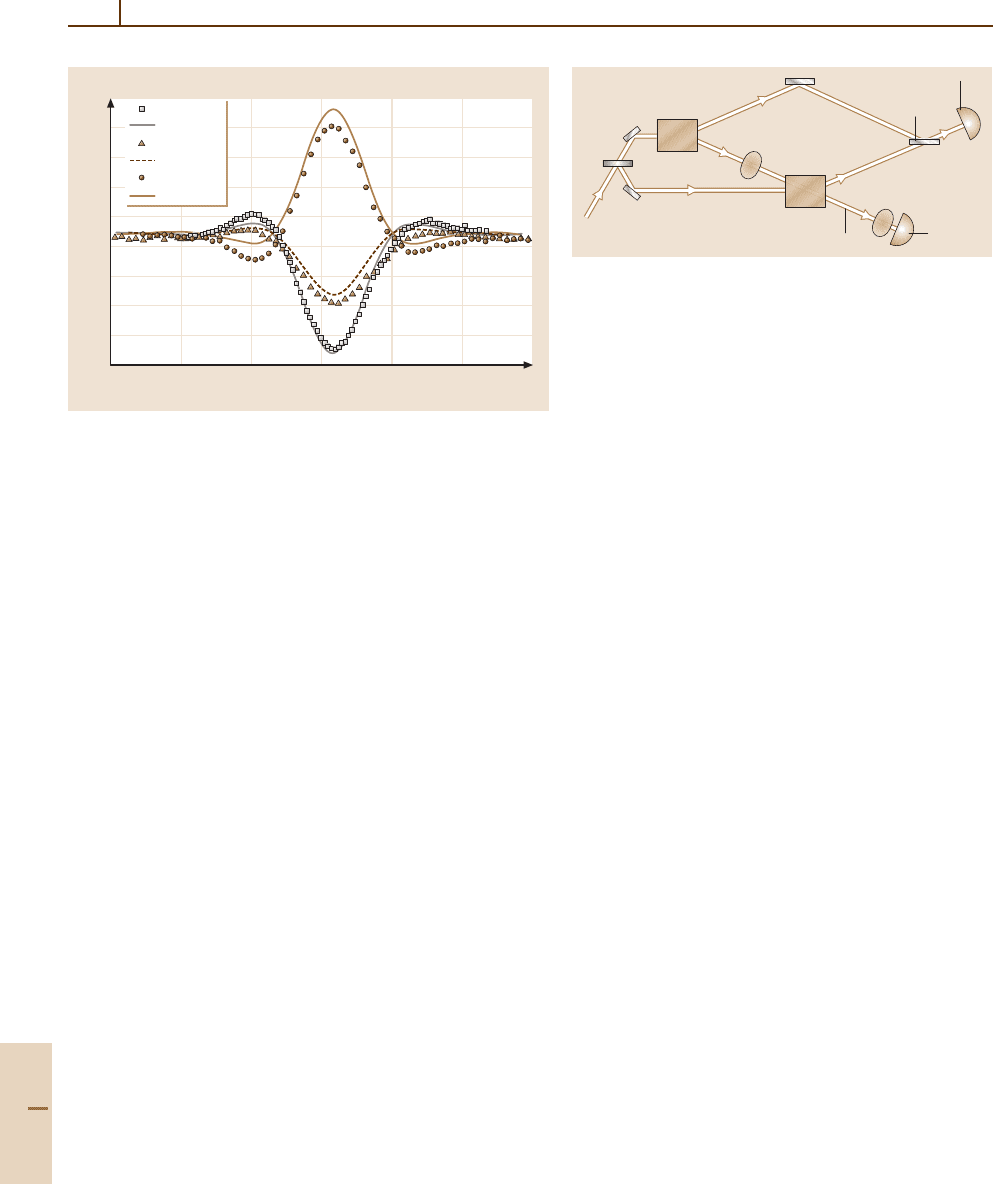
1192 Part F Quantum Optics
450
400
350
300
250
200
150
100
50
0
–1110
–1090 –1070 –1050 –1030 –990–1010
Trombone prism position (µm)
Coincidence rate (s
–1
)
45°, 45°
Theory
45°, 22°
Theory
45°, –45°
Theory
Fig. 80.5 Experimental data and scaled theoretical curves (adjusted
to fit observed visibility of 91%) with polarizer 1 at 45
◦
and polar-
izer 2 at various angles. Far from the dip, there is no interference
and the angle is irrelevant [80.92]
Wheeler [80.106], and the experiments by Hellmuth
et al. and Alley et al. [80.107,108], in which the decision
to display wave-like or particle-like aspects in a light
beam may be delayed until after the beam has been split
by the appropriate optics.) But in all cases, one must
correlate the results of measurements on the MA with
the detection of the originally interfering system. This
requirement precludes any possibility for superluminal
signaling.
In a related atom-optics experiment, researchers ob-
served contrast loss in an atom interferometer when
single photons were scattered off the atoms (yielding
which-path information) [80.110]. They further demon-
strated that the lost coherence could be recovered by
observing only atoms that were correlated with photons
emitted into a limited angular range, in essence realizing
a quantum eraser.
80.4.3 Vacuum-Induced Coherence
A somewhat different demonstration [80.109, 111]of
complementarity involves two down-conversion crys-
tals, NL1 and NL2, aligned such that the trajectories of
the idler photons from each crystal overlap (Fig. 80.6).
A beam splitter acts to mix the signal modes. If the
path lengths are adjusted correctly, and the idler beams
overlap precisely, there is no way to tell, even in prin-
ciple, from which crystal a photon detected at D
s
originated. Interference appears in the signal singles
rate at D
s
, as any of the path lengths is varied. If the
UV
NL1
NL2
s
1
s
2
i
1
, i
2
BS
A
B
D
s
D
i
i
1
Fig. 80.6 Schematic of setup used in [80.109]. The idler
photons from the two crystals are indistinguishable; conse-
quently, interference fringes may be observed in the signal
singles rate at detector D
s
. Additional elements at A and B
can be used to make a quantum eraser
idler beam from crystal NL1 is prevented from enter-
ing crystal NL2, then the interference vanishes, because
the presence or absence of an idler photon at D
i
then
“labels” the parent crystal. One explanation for the
effect of blocking this path is that coherence is es-
tablished by the idler-mode vacuum field seen by both
crystals.
Experiments have also been performed in which
a time-dependent gate is introduced in the idler arm
between the two crystals [80.112]. As one expects, the
presence or absence of interference depends on the ear-
lier state of the gate, at the time when the idler photon
amplitude was passing through it.
80.4.4 Suppression
of Spontaneous Down-Conversion
A modification [80.113] of this two-crystal experiment
uses only a single nonlinear crystal (Fig. 80.7). A given
pump photon may down-convert in its initial right-ward
passage through the crystal, or in its left-going return
trip (or not at all, the most likely outcome). As in the
previous experiment, the idler modes from these two
processes are made to overlap; moreover, the signal
modes are also aligned to overlap. Thus, the left-going
and right-going production processes are indistinguish-
able and interfere. The result is that fringes are observed
in all of the counting rates (i. e., the coincidence rate
and both singles rates) as any of the mirrors is trans-
lated. A different interpretation is as a change in the
spontaneous emission of the down-converted photons,
akin to the suppression of spontaneous emission in cav-
ity QED demonstrations, discussed in Sects 80.2.1 and
79.2. Subsequent theoretical and experimental work has
shown that, in a sense, there are always photons be-
tween the down-conversion crystal and the mirrors, even
Part F 80.4
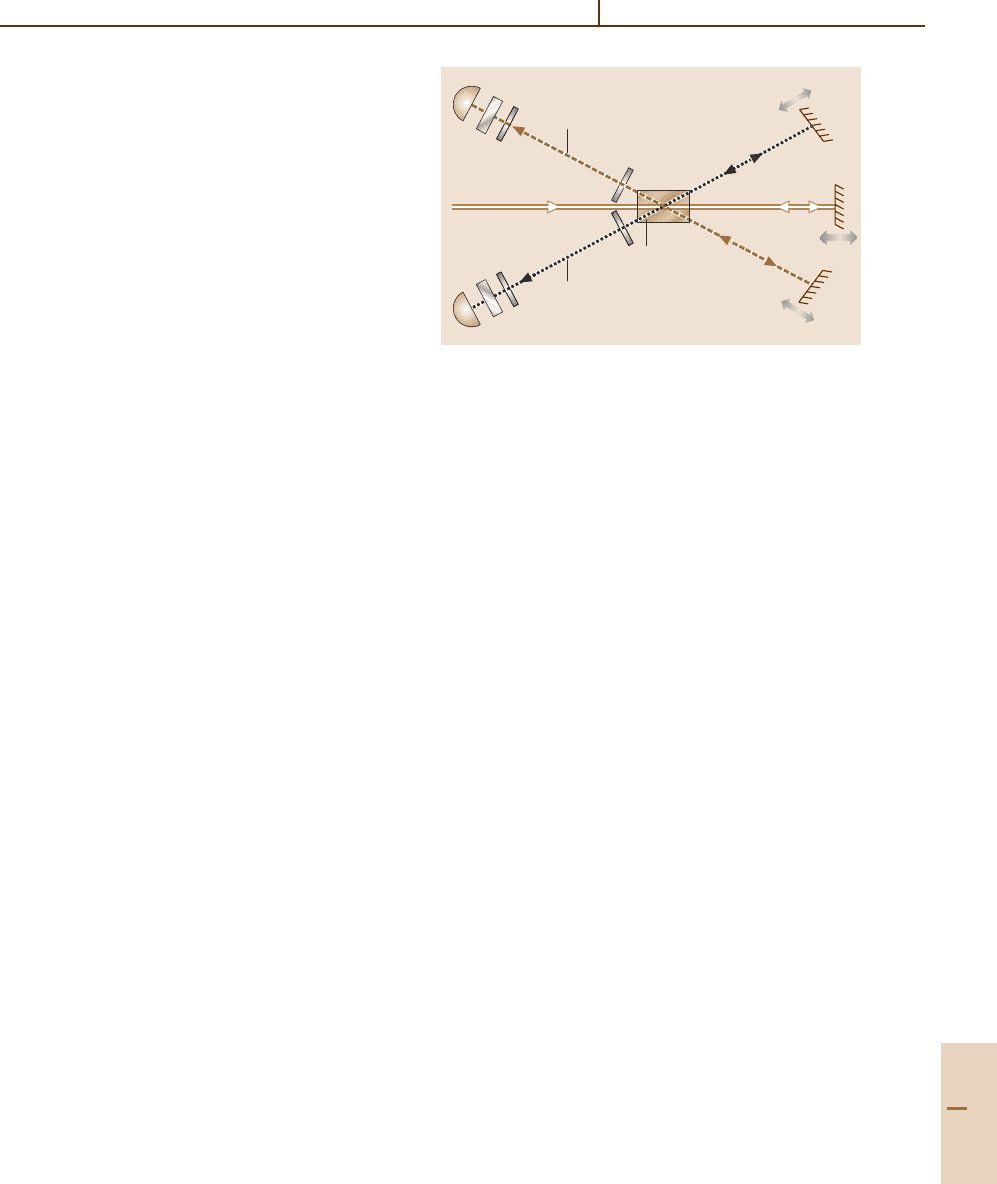
Quantum Optical Tests of the Foundations of Physics 80.5 Measurements in Quantum Mechanics 1193
in the case of complete suppression of the spontaneous
emission process [80.114, 115]. This same conclusion
should also apply in the atom case [80.116], though
in contrast to that system, for the down-conversion ex-
periment the distances to the mirrors are much longer
than the coherence lengths of the spontaneously emitted
photons.
One recent application of this phenomenon is to
study effective nonlinearities at the single-photon level,
which has enabled the construction of a 2-photon
switch [80.117]. Finally, with the inclusion of wave-
plates to label the photons’ paths, and polarizers to
erase this information, an improved quantum eraser ex-
periment was also completed, in which the which-path
information for one photon was carried by the other
photon [80.104].
Pump
Signal
Idler
LiIO
3
Fig. 80.7 Schematic of the experiment to demonstrate
enhancement and suppression of spontaneous down-
conversion [80.113]
80.5 Measurements in Quantum Mechanics
80.5.1 Quantum (Anti-)Zeno Effect
A strong measurement of a quantum system will project
it into one of its eigenstates [80.95]. If the system evolves
slowly out of its initial state: |Ψ(t = 0)= |Ψ
0
→
(1 −t
2
/τ
2
)
1/2
|Ψ
0
+t/τ|Ψ
1
, then repeated measure-
ments with an interval much less than τ can inhibit this
evolution. If there are N total measurements within τ,
then the probability for the system to still be in the ini-
tial state is P(τ) =
1 −(τ/N )
2
/τ
2
N
→ 1asN →∞.
This phenomenon, known as the quantum Zeno ef-
fect [80.118], has been experimentally observed using
3levelsin
9
Be
+
ions [80.119]. The ions were prepared
in state |i, and weakly coupled to state | f via RF ra-
diation that induced a slow Rabi oscillation between
the two states. Thus, in the absence of any interven-
ing measurements, the ions evolved sinusoidally into
state | f . When rapid measurements were made (by
a laser strongly coupling state | f to readout state |r,
hence leading to strong fluorescence only if the atom was
in state | f ), the effect was to inhibit the |i→|f tran-
sition. Note that here it was the absence of fluorescent
photons which projected the state at each measurement
back into the state |i (Sect. 80.5.3). Also, although we
have explained the effect in terms of a repeated “col-
lapse” of the wave function back into its initial state,
equally valid explanations without such reductions are
also possible [80.120, 121].
Koffman and Kurizki have pointed out that the
above inhibition phenomenon depends on there being
a bounded number of final states (the ion example had
only one). If instead the measurement process actu-
ally increases the number of accessible final states | f ,
then one obtains the “anti-Zeno” effect, in which the
|i→|f rate is enhanced rather than suppressed by fre-
quent measurements [80.122]. For example, this would
be the case in the ion example if the |i→|f transition
were spontaneous (allowing all frequencies) instead of
driven (proceeding only at the driving Rabi frequency).
The anti-Zeno effect has been observed by monitoring
the survival time (against tunneling escape) of atoms
trapped in an accelerating far-detuned standing wave of
light [80.123].
80.5.2 Quantum Nondemolition
The uncertainty principle between the number of
quanta N and phase φ of a beam of light,
∆N∆φ ≥1/2 ,
(80.8)
implies that to know the number of photons exactly,
one must give up all knowledge of the phase of the
wave. In theory, a quantum nondemolition (QND)pro-
cess is possible [80.124]: without annihilating any of
the light quanta, one can count them. It might seem
that this would make possible successive measurements
on noncommuting observables of a single photon, in
violation of the uncertainty principle; it is the unavoid-
able introduction of phase uncertainty by any number
measurement which prevents this.
QND schemes [80.125] often employ the intensity-
dependent index of refraction arising from the optical
Part F 80.5

1194 Part F Quantum Optics
Kerr effect (Sect. 72.4.2) – the change in the index due
to the intensity of the “signal” beam changes the opti-
cal phase shift on a “probe” beam [80.126–128]. Other
proposals include using the Aharonov–Bohm effect to
sense photons via the phase shift their fields induce in
passing electrons [80.129, 130]. To date the closest ex-
perimental realization [80.26]ofaQND measurement
– of the photon number in a microwave cavity – was
performed by passing Rydberg atoms [80.131, 132]in
a superposition of the ground and excited states through
the cavity. The interaction with the cavity photon is ad-
justed to be equivalent to a 2 π-pulse (Sect. 79.5). The
result is that in the absence of any photon, the quantum
state of the atoms after the cavity was unchanged; with
a photon in the cavity, the ground state acquired an extra
relative phase of π, which was then detected by measur-
ing the atom’s quantum state. An efficiency approaching
50% was achieved. Recently, it was suggested that opti-
cal QND measurements could enable scalable quantum
computing [80.133].
80.5.3 Quantum Interrogation
The previous section described techniques to measure
the presence of a photon without absorbing it. Now we
discuss a method – quantum interrogation – to optically
detect the presence of an object without absorbing or
scattering a photon. The possibility that the absence of
a detection event – a “negative-result” measurement –
can lead to wavepacket reduction was first discussed by
Renninger [80.134] and later by Dicke [80.135]. Here we
consider the Gedankenexperiment proposed by Elitzur
and Va i d man (EV), a simple single-particle interferom-
eter, with particles injected one at a time [80.136]. The
path lengths are adjusted so that all the particles leave
a given output port (A), and never the other (B). Now
suppose that a nontransmitting object is inserted into one
of the interferometer’s two arms – to emphasize the re-
sult, EV considered an infinitely sensitive “bomb”, such
that interaction with even a single photon would cause it
to explode. By classical intuition, any attempt to check
for the presence of the bomb involves interacting with
it in some way, and, by hypothesis, inevitably setting it
off.
Quantum mechanics, however, allows one to be cer-
tain some fraction of the time that the bomb is in place,
without setting it off. After the first beam splitter of
the interferometer, a photon has a 50% chance of head-
ing towards the bomb, and thus exploding it. On the
other hand, if the photon takes the path without the
bomb, there is no more interference, since the nonex-
plosion of the bomb provides welcher Weg (“which
way”) information (see Sect. 80.4.1). Thus the photon
reaches the final beam splitter and chooses randomly
between the two exit ports. Some of the time (25%), it
leaves by output port B, something which never hap-
pened in the absence of the bomb. This immediately
implies that the bomb (or some nontransmitting object)
is in place – even though (since the bomb is unexploded)
it has not interacted with any photon; EV termed this
an “interaction-free measurement”. (We prefer the more
general description “quantum interrogation”, which then
includes cases – e.g., detecting a semi-transparent or
quantum object – where it may not be possible to logi-
cally exclude the possibility of an interaction.) It is the
mere possibility that the bomb could have interacted
with a photon which destroys interference. An initial
experimental implementation of these ideas [80.137]
used down-conversion to prepare the single photon states
(Sect. 80.1), and a single-photon detector as the “bomb”.
Subsequently the technique was implemented incorpo-
rating focusing lenses, which would enable the image
(more correctly, the silhouette) of an object to be de-
termined with less than one photon per “pixel” being
absorbed [80.138].
By adjusting the beamsplitter reflectivities in the
above example, one can achieve at most a 50% frac-
tion of measurements that are interaction-free. An
improved method, relying on the quantum Zeno ef-
fect [80.118] (Sect. 80.5.1), was discovered with which
one can in principle make this fraction arbitrarily close
to 1 [80.137]. For example, consider a photon initially
in cavity #1 of two identical cavities coupled by a loss-
less beam splitter whose reflectivity R = cos
2
(π/2N ).
If the photon’s coherence length is shorter than the cav-
ity length, after N cycles the photon will with certainty
be located in cavity #2, due to an interference effect (the
equivalent of a π-pulse interaction). However, if cav-
ity #2 instead contains an absorbing object (e.g., the
ultra-sensitive bomb), at each cycle there is only a small
chance (= 1 − R) that the photon will be absorbed; oth-
erwise, the non absorption projects the photon wave
packet entirely back onto cavity #1. After all N cycles,
the total probability for the photon to be absorbed by the
object is 1 − R
N
, which goes to 0 as N becomes large.
(In practice, unavoidable losses in the system limit the
maximum number of cycles and hence the achievable
performance [80.139].) The photon effectively becomes
trapped in cavity #1, thus indicating umambiguously the
presence of the object in cavity #2.
This quantum-Zeno version of interrogation was
first implemented using the inhibited rotation of a pho-
Part F 80.5

Quantum Optical Tests of the Foundations of Physics 80.6 The EPR Paradox and Bell’s Inequalities 1195
ton’s polarization (the object to be detected blocked
one arm of a polarizing interferometer through which
the photon was repeatedly cycled), achieving an effi-
ciency of 75% [80.139]. A cavity-based implementation,
in which the presence of the absorbing object inside
a high-finesse cavity vastly increased the reflection off
the cavity [80.140], detected the presence of the object
with only 0.15 photons on average being absorbed or
scattered [80.141].
80.5.4 Weak and “Protected”
Measurements
Aharonov, Albert,andVa idma n extended quantum mea-
surement theory by introducing “weak” measurement,
a procedure that determines a physical property of
a quantum system belonging to an ensemble that is
both preselected and postselected [80.142, 143]. In the
standard theory, a quantum system is measured by
entangling its eigenstates with distinguishable pointer
states of a measurement device, completely resolving
the observable eigenvalue spectrum. The measure-
ment can be weakened by increasing the overlap of
the pointer states, consequently reducing the resolu-
tion of the eigenstates. When performed between two
measurements this can give surprising results – in
contrast to ordinary expectation values, the pointer
can lie outside the range of the eigenvalue spec-
trum of the measured observable O. The “weak
value” O
w
≡Ψ
ini
|O|Ψ
fin
/Ψ
fin
|Ψ
ini
between prese-
lected (|Ψ
ini
) and postselected (|Ψ
fin
) states completely
characterizes the outcome of the weak measurement.
Weak measurements do not disturb each other, so that
the weak values of non-commuting observables can
be measured simultaneously [80.144, 145]. Further-
more, they have proved to yield meaningful results in
many different circumstances, e.g., Hardy’s paradox of
Sect. 80.6.5 [80.146], measurement of negative kinetic
energies [80.147], and the “observation” of a single
particle in two locations [80.148]. One other poten-
tially powerful application of weak measurements is the
amplification of weak signals, which was first demon-
strated by amplifying the birefringence-induced small
displacement of optical fields [80.149, 150]. It was re-
cently shown that weak measurements of this kind in
fact arise naturally in fiber optics telecom networks,
due to polarization-mode dispersion and polarization-
dependent losses [80.151]. One recent proposal [80.152]
suggests that the controversy over whether or not
“welcher Weg” information may be obtained (and in-
terference consequently destroyed) without disturbing
a particle’s momentum (Sect. 80.4.2) may be resolved
by making weak measurements of momentum inside an
interferometer.
The above results push us to reexamine our interpre-
tation of wave functions. We customarily use the wave
function only as a calculational tool, but we have also
learned that it is in some sense physical, and should not
be regarded merely as some distribution from classical
statistics. One proposal [80.153, 154] suggests that the
wave function of a single particle should be regarded as
a real entity. When a state is “protected” from change,
e.g., by an energy gap, and measurements are performed
sufficiently “gently”, one should be able to determine not
just the expectation value of position, but the wave func-
tion at many different positions, without altering the state
of the particle. (This idea of measuring the entire wave
function of a single particle should not be conflated with
Raymer et al.’s fascinating work on the reconstruction of
the quantum state of a light field by repeated sampling
of a large ensemble; see [80.155] and Sect. 78.4.) No
violation of the uncertainty principle or the no-cloning
theorem (Sect. 80.7.1) arises from this, as the ability
to “protect” a state relies on some preexisting knowl-
edge about the state; but it assigns a deeper significance
to the wave function, one Aharonov terms “ontolog-
ical,” as opposed to merely epistemological (but see
also [80.156]).
80.6 The EPR Paradox and Bell’s Inequalities
80.6.1 Generalities
Nowhere is the nonlocal character of the quantum
mechanical entangled state as evident as in the “para-
dox” of Einstein, Podolsky,andRosen (EPR) [80.157],
the version of Bohm [80.158], and the related in-
equalities by Bell [80.159, 160]. Consider two photons
traveling off back-to-back, described by the entangled
state
|ψ
−
=
(
|H
1
, V
2
−|V
1
, H
2
)
/
√
2 , (80.9)
where the letters denote horizontal (H) or vertical (V)
polarization, and the subscripts denote photon propaga-
tion direction. This state, analogous to the singlet state
of a pair of spin-1/2 particles, is isotropic – it has the
same form regardless of what basis is used to describe
Part F 80.6

1196 Part F Quantum Optics
it. Measurement of any polarization component for one
of the particles will yield a count with 50% probability;
individually, each particle is unpolarized. Nevertheless,
if one measures the polarization component of particle 1
in any basis, one can predict with certainty the po-
larization of particle 2 in the same basis, seemingly
without disturbing it, since it may be arbitrarily remote.
Therefore, according to EPR, to avoid any nonlocal in-
fluences one should ascribe an “element of reality” to
every component of polarization. A quantum mechan-
ical state cannot specify that much information, and is
consequently an incomplete description, according to
the EPR argument. The intuitive explanation implied
by EPR is that the particles leave the source with def-
inite, correlated properties, determined by some local
“hidden variables” not present in quantum mechanics
(QM).
For two entangled particles, a local hidden variable
(LHV) theory can be made which correctly describes
perfect correlations or anti-correlations (i. e., measure-
ments made in the same polarization basis). The choice
of an LHV theory versus QM is then a philosophical
decision, not a physical one. However, in 1964 John
Bell [80.159] discovered that QM gives different statis-
tical predictions than does any LHV theory, for situations
of nonperfect correlations (i. e., analyzers at intermedi-
ate angles). Bell’s inequality (BI) constrains various joint
probabilities given by any local realistic theory, and was
later generalized to include any model incorporating lo-
cality [80.161, 162], and also extended to apply to real
experimental situations [80.163, 164]. With the caveat
of supplementary assumptions (Sect. 80.6.4), Bell’s in-
equalities have now been tested many times, and the vast
majority of experiments have violated them, in support
of QM. One general interpretation is that the predictions
of QM cannot be reproduced by any completely local
theory. It must be that the results of measurements on
one of the particles depend on the results for the other,
and these correlations are not merely due to a common
cause at their creation [80.165, 166].
80.6.2 Polarization-Based Tests
The first BI tests were performed with pairs of pho-
tons produced via an atomic cascade, and a later version
incorporated rapid (albeit periodic) switching of the
analyzers [80.167, 168]. Unfortunately, the angular cor-
relation of the cascade photons is not very strong. In
contrast, the strong correlations of the down-converted
photons make them ideal for such tests, the first of which
were performed using setups essentially identical to that
already discussed in connection with quantum erasure
(Fig. 80.4). Orthogonally polarized (e.g., horizontal and
vertical) but otherwise identical photons are combined
on a nonpolarizing 50–50 beam splitter. If one consid-
ers only the events with a single photon in each output
(i. e., ignoring the cases for which both photons use the
same beam splitter output port), one obtains the (post-
selected) entangled state (80.9) [80.169, 170]. (In fact,
this technique is now used as a method for characteriz-
ing the indistinguishability of photons from independent
sources, e.g., quantum dots [80.171] or independent
down-conversion crystals [80.172, 173].)
Down-conversion schemes have also been developed
to produce entangled states without the need to post-
select out half of the photons. For example, consider
a type-I phase-matched crystal (Sect. 72.2.2) that down-
converts H-polarized pump photons into V-polarized
pairs; and an adjacent, identical crystal that is rotated
by 90
◦
, thus down-converting V-polarized pump pho-
tons into H-polarized pairs. By coherently pumping
the two crystals with light polarized at |45≡(|V +
|H)/
√
2, one obtains the entangled state (|HH +
|VV /
√
2. (More generally, pumping α|V +e
iϕ
β|H
produces arbitrary nonmaximally entangled states of
the form α|HH+e
iϕ
β|VV [80.174].) Such a source
has produced the largest and fastest violations of Bell
inequalities to date (over 200-σ violation in less than
1 second) [80.175, 176].
Using type-II phase-matching one also can pro-
duce polarization entanglement from a single crys-
tal [80.177]. One member of each down-conversion
pair is emitted along an ordinary polarized cone while
the other is emitted along an extraordinary polarized
cone. If the photons happen to be emitted along the
intersection of the two cones, neither photon will have
a definite polarization – they will be in the state (|HV +
|VH /
√
2. This entanglement source has now been
used in a variety of quantum investigations, including
Bell inequality tests [80.177, 178], quantum cryptog-
raphy [80.179, 180] (Sect. 80.7.4 and Chapt. 81)and
teleportation [80.181, 182], and as a resource for study-
ing entanglement of more than 2 photons [80.37–42].
80.6.3 Nonpolarization Tests
The advent of parametric down-conversion has also led
to the appearance of several nonpolarization-based BI
tests, using, for example, an entanglement of the pho-
ton momenta (Fig. 80.8) [80.183]. By use of small irises
(labeled ‘A’ in the figure), Rarity and Tapster examined
four down-conversion modes: 1s, 1i, 2s, and 2i. Beams
Part F 80.6
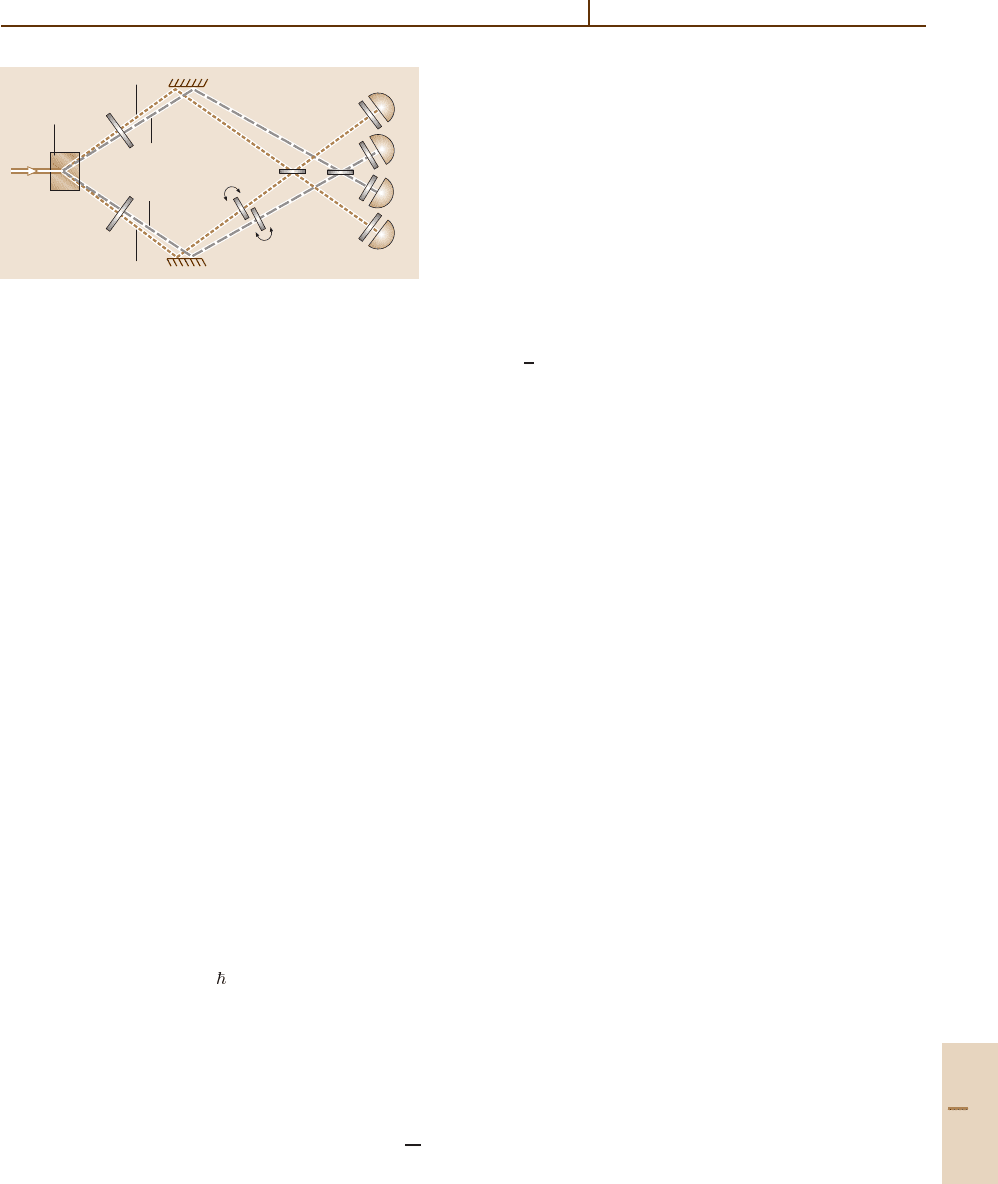
Quantum Optical Tests of the Foundations of Physics 80.6 The EPR Paradox and Bell’s Inequalities 1197
UV
KD*P
1s
2i
A
A
1i
2s
P
s
P
i
D
s
D
i
D
i
D
s
Fig. 80.8 Outline of Rarity and Tapster apparatus used
to demonstrate a violation of a Bell’s inequality based on
momentum entanglement [80.183]
1s and 1i correspond to one pair of conjugate photons;
beams 2s and 2i correspond to a different pair. Photons
in beams 1s and 2s have the same wavelength, as do
photons in beams 1i and 2i. With proper alignment, af-
ter the beam splitters there is no way to tell whether
a pair of photons came from the 1s–1i or the 2s–2i
paths. Consequently, the coincidence rates display inter-
ference, although the singles rates at the four detectors
indicated in Fig. 80.8 remain constant. This interference
depends on the difference of phase shifts induced by
rotatable glass plates P
i
and P
s
in paths 1i and 2s, re-
spectively, and is formally equivalent to the polarization
case considered above, in which it is the difference of
polarization-analyzer angles that is relevant. By measur-
ing the coincidence rates for two values for each of the
phase shifters – a total of four combinations – the ex-
perimenters were able to violate an appropriate BI.One
interpretation is that the emission directions of a given
pair of photons are not elements of reality.
Momentum conservation in the down-conversion
process (80.4) also leads to entanglement directly in the
spatial modes in the correlated photons. For example,
Zeilinger et al. [80.184, 185]andWhite et al. [80.186]
have demonstrated entanglement between the orbital an-
gular momentum of the photons, of the form (|+1,
−1+|0, 0+|−1, +1, where 0 and ±1 respectively
denote modes with no orbital angular momentum (gaus-
sian spatial profiles) and ±
(Laguerre–Gauss-Vortex
modes). Note that this enables one to investigate cor-
relations for degrees of freedom that reside in larger
Hilbert spaces than do the 2-level systems (e.g., polariza-
tion) discussed above. The nonlocal spatial correlations
of the down-conversion photons have also given rise to
many interesting experiments in the area of quantum
imaging [80.187–190], where one is able to obtain spa-
tial resolution beyond that predicted by the usual
√
N
shot-noise limitations.
Several groups [80.191, 192] have violated a BI
based on energy–time entanglement of the pho-
tons [80.193]. In the method due to Franson, one
member of each down-converted pair is directed into an
unbalanced Mach–Zehnder-like interferometer, allow-
ing both a short and long path to the final beam splitter;
the other photon is directed into a separate but simi-
lar interferometer. There arises interference between the
indistinguishable processes (“short–short” and “long–
long”) which could lead to coincidence detection. Using
fast detectors to select out only these processes, the
reduced state (80.9)is
|ψ=
1
2
|S
1
, S
2
−e
iφ
|L
1
, L
2
, (80.10)
where the letters indicate the short or long path, and
the phase is the sum of the relative phases in each
interferometer. Although no fringes are seen in any of
the singles count rates, the high-visibility coincidence
fringes (Fig. 80.9) lead to a violation of an appropriate
BI. One conclusion is that it is incorrect to ascribe to
the photons a definite time of emission from the crystal,
or even a definite energy, unless these observables are
explicitly measured.
This same sort of arrangement, modified to work
with a pulsed pump, has been used to demonstrate the
longest violation of local realism, in which Gisin’s group
has observed a 16-σ BI violation (modulo the detec-
tion and timing loopholes discussed in Sect. 80.6.4) with
photons separated by 10.9 km [80.194]. In a related ex-
periment, they have used a similar system to place limits
on the “speed of collapse” of the 2-photon wave func-
tion, i. e., how fast a nonlocal “signal” would need to
propagate from one side of the experiment to the other
to account for the measured nonclassical correlations.
Depending on some assumptions about the detection
process and which inertial frame of reference is consid-
ered, the nonlocal-influence speed was constrained to be
at least 10
4
c to 10
7
c [80.195]. In one interesting vari-
ant, the researchers arranged to have moving detectors,
such that in the local reference frame of each detector, it
was the other detector which initiated the collapse. (Due
to the experimental difficulty of accelerating actual de-
tectors to high velocities, a rapidly rotating absorbing
disk was placed close to one output port of a polarizing
beamsplitter; following ideas discussed in Sect. 80.5.3,
the non-absorbance of the photon by the absorber was
deemed sufficient to cause a reduction of the wave func-
tion.) As expected, the measured correlations were in no
way reduced, but this experiment did rule out one alter-
native theory of nonlocal collapse [80.196,197]. Finally,
Part F 80.6
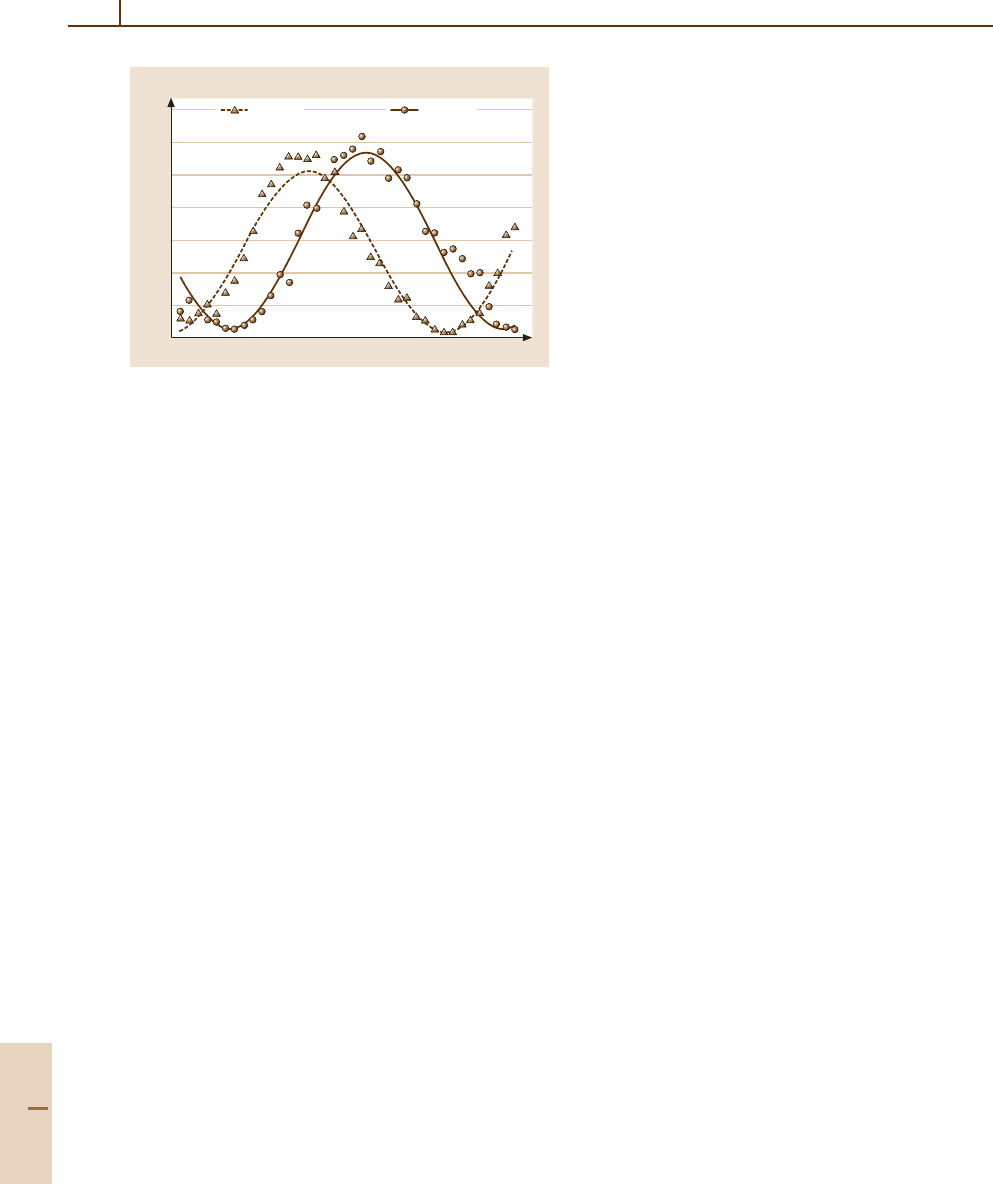
1198 Part F Quantum Optics
700
600
500
400
300
200
100
0
Coincidence counts N
12
(per 24 s)
Interferometer 1 phase shift,
1
2
2
= 0° = 90°
Visib. = 92.8 0.9 % Visib. = 90.3 0.7%
Fig. 80.9 High-visibility coincidence fringes in a Franson
dual-interferometer experiment [80.192] for two values of
the phase in interferometer 2 as the phase in interferometer 1
is slowly varied. The curves are sinusoidal fits
by using more than two possible creation times, e.g.,
with a mode-locked pulsed laser, Gisin’s group demon-
strated entanglement for a two-photon state in a Hilbert
space of at least dimension 11 [80.198].
EPR-like correlations have also been observed di-
rectly between two correlated field modes via homodyne
tomography [80.199], though the joint Wigner function
is positive-definite here. In contrast, a homodyne meas-
urement on the state of a single photon split between two
paths (Sect. 80.4.4) took advantage of the nonclassical
nature of the initial state to violate a Bell inequality
[80.46]. Like all existing Bell-inequality experiments,
this work suffered from several loopholes (Sect. 80.6.4),
but a new proposal suggests that the high efficiency of
homodyne detection may provide a unique opportunity
for a loophole-free test of Bell’s inequalities [80.200].
80.6.4 Bell Inequality Loopholes
In fact, to date no single experiment has unambigu-
ously violated a Bell inequality, due to the existence
of two experimental challenges, the detection and local-
ity “loopholes”. All of the experiments discussed thus
far have required supplementary assumptions, e.g., the
“fair-sampling” assumption that the fraction of pairs de-
tected is representative of the entire ensemble emitted by
the source. [In fact, for the entangled photons emitted in
the atomic cascade experiments, this assumption is man-
ifestly false, because the strong polarization correlations
only exist for those photons emitted nearly in opposite
directions. If one were to collect all of the emitted pho-
ton pairs, they would not lead to a violation (see [80.201]
for a fuller discussion).] To close the locality (or “tim-
ing”) loophole requires that the analyzer settings be
switched rapidly and randomly, in order to guaran-
tee that no (sub)luminal information transfer could
account for the observed correlations. The necessary
conditions have been met only in the down-conversion
experiment by Zeilinger et al., which separated the
photons by 400 m and used ultrafast random number
generation and electronic polarization-analysis choice
to ensure space-like separated observers [80.178]. How-
ever, in that experiment the detection efficiency was less
than 5%.
In order to understand the detection loophole,
consider the Clauser–Horne (CH) form of the Bell in-
equality [80.164], which relates the directly observable
singles rates S
1
and S
2
and the coincidence rate C
12
,
rather than “inferred” probabilities, by
C
12
(a, b) +C
12
(a, b
) +C
12
(a
, b) −C
12
(a
, b
)
≤ S
1
(a) +S
2
(b), (80.11)
where a and a
(b and b
) are any pair of analyzer (e.g.,
polarizer) settings at detector 1 (2). For certain choices
of a, a
, b,andb
, quantum mechanics predicts the left
hand side of the CH inequality can exceed the right
hand side. However, in practice this is very difficult to
observe, since the coincidence rates fall as η
2
(η is the
detection efficiency), compared to the singles rates on
the right hand side, which fall only as η. In order to close
the detection loophole, one requires η ≥ 83% [80.201]
(for maximally entangled photons. (Eberhard has shown
that the required detection efficiency may be reduced to
67% by using nonmaximally entangled quantum sys-
tems [80.202, 203]. The idea is that one can choose the
analysis settings a and b to reduce the value of the RHS
of the CH inequality.) In essence, one requires high de-
tection efficiencies to ensure that the contributions from
undetected events are not sufficient to cause the total
ensemble to satisfy the Bell inequality even while the
detected events violate it.
To date, only the entangled-ion experiment of
Wineland et al. [80.204] has had sufficiently high
efficiencies to close the detection loophole. In this ex-
periment the entangled variables were the hyperfine
energy levels of
9
Be
+
ions. By employing a cy-
cling transition that leads to the emission of many
photons if the atom is in one of the states, a de-
tection efficiency in excess of 98% was achieved,
allowing an 8-σ Bell inequality violation. However,
because the ions were separated by only 3 µmin
the same linear Paul trap, and in fact were measured
Part F 80.6
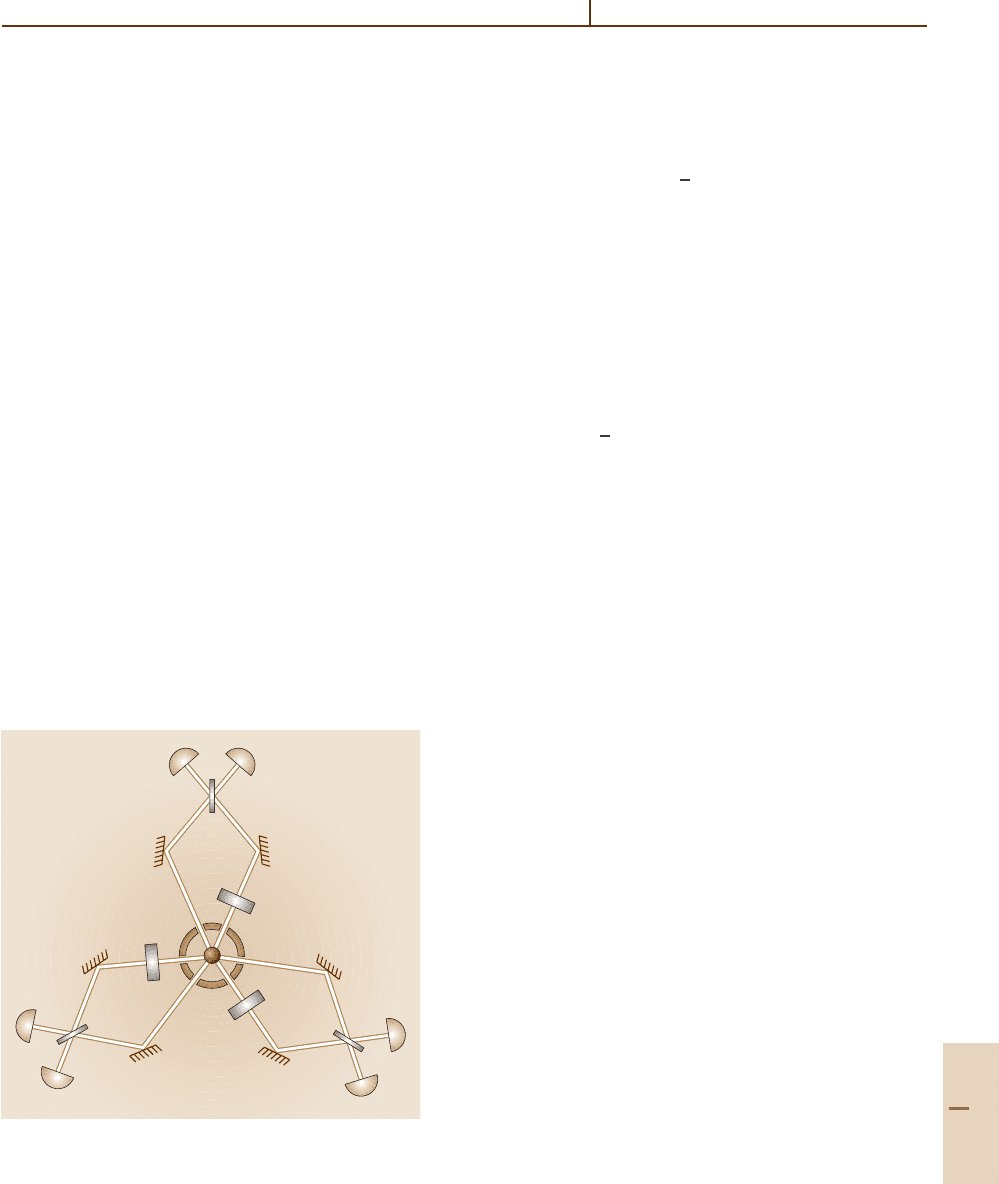
Quantum Optical Tests of the Foundations of Physics 80.6 The EPR Paradox and Bell’s Inequalities 1199
using the same laser pulse, there was no possibil-
ity of closing the locality loophole. More recently,
Monroe et al. have demonstrated the entanglement
of a trapped ion and a photon [80.205], and have
used this to violate a Bell inequality [80.206]. Sim-
ilar experiments have also enabled the production of
up to four entangled ions [80.207]. Though neither
of the experimental loopholes was closed in these
experiments, they are noteworthy as the first con-
trolled demonstrations of entanglement in massive
particles. Efforts are now underway to attempt a di-
rect violation of (80.11) with no auxiliary assumptions
using down-conversion photons and high-efficiency
(> 85%) single-photon detectors [80.208, 209], in ad-
dition to atomic schemes [80.210] and homodyne
schemes [80.200] (Sect. 80.6.3), which enjoy even
higher intrinsic efficiency.
80.6.5 Nonlocality Without Inequalities
In the above experiments for testing nonlocality, the
disagreement between quantum predictions and Bell’s
constraints on local realistic theories are only statistical.
Greenberger, Horne,andZeilinger (GHZ) pointed out
that in some systems involving three or more entangled
particles, a contradiction could arise even at the level of
perfect correlations [80.211, 212]. A schematic of one
version of the GHZ Gedankenexperiment is shown in
Fig. 80.10. The source at the center is posited to emit
aa
Φ
a
c
c
Φ
c
Φ
b
b
b
α
α
γ
γ
β
β
Fig. 80.10 A three-particle Gedankenexperiment to demon-
strate the inconsistency of quantum mechanics and any local
realistic theory. All beam splitters are 50–50 [80.111]
trios of correlated particles. Just as the Rarity–Tapster
experiment selected two pairs of photons (Fig. 80.8),
the GHZ source selects two trios of photons; these are
denoted by abc and a
b
c
. Hence, the state coming from
the source may be written
|ψ=
|abc+|a
b
c
/
√
2 . (80.12)
After passing through a variable phase shifter (e.g., φ
a
),
each primed beam is recombined with the correspond-
ing unprimed beam at a 50–50 beam splitter. Detectors
(denoted by Greek letters) at the output ports signal
the occurrence of triple coincidences. The following
simplified argument conveys the spirit of the GHZ result.
Given the state (80.12), one can calculate from
standard QM the probability of a triple coincidence as
a function of the three phase shifts:
P(φ
1
,φ
2
,φ
3
) =
1
8
[
1 ±sin(φ
a
+φ
b
+φ
c
)
]
,
(80.13)
where the plus sign applies for coincidences between
all unprimed detectors, and the minus sign for coin-
cidences between all primed detectors. For the case in
which all phases are 0, it will occasionally happen (1/8th
of the time) that there will be a triple coincidence of all
primed detectors. Using a “contrafactual” approach, we
ask what would have happened if φ
a
had been π/2in-
stead. By the locality assumption, this would not change
the state from the source, nor the fact that detectors
β
and γ
went off. But from (80.13) the probability
of a triple coincidence for primed detectors is zero in
this case; therefore, we can conclude that detector α
would have “clicked” if φ
a
had been π/2. Similarly, if
φ
b
or φ
c
had been π/2, then detectors β or γ would
have clicked. Consequently, if all the phases had been
equal to π/2, we would have seen a triple coincidence
between unprimed detectors. But according to (80.13)
this is impossible: the probability of triple coincidences
between unprimed detectors when all three phases are
equal to π/2 is strictly zero! Hence, if one believes the
quantum mechanical predictions for these cases of per-
fect correlations, it is not possible to have a consistent
local realistic model.
Down-conversion experiments have enabled the pro-
duction of 3- and 4-photon GHZ states, with results
in good agreement with theory (the all-or-nothing ar-
guments given above become inequalities in any real
experiment) [80.37–39].
By similar arguments, Hardy has shown the incon-
sistency of quantum mechanics and local realism in
a Gedankenexperiment with just two particles [80.213,
214]. When the arguments are suitably modified to
Part F 80.6
